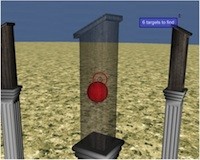Navigational Search in VR: Do we need to walk?
Do we need full physical motions for effective navigation through Virtual Environments? Recent results suggest that translations might not be as important as previously believed, which could enable us to reduce overall simulation effort and cost
Physical rotations and translations are the basic constituents of navigation behavior, yet there is mixed evidence about their relative importance for complex navigation in virtual reality (VR). In the present experiment, 24 participants wore head-mounted displays and performed navigational search tasks with rotations/translations controlled by physical motion or joystick. As expected, physical walking showed performance benefits over joystick navigation. Controlling translations via joystick and rotations via physical rotations led to better performance than joystick navigation, and yielded almost comparable performance to actual walking in terms of search efficiency and time. Walking resulted, however, in increased viewpoint changes and shorter navigation paths, suggesting a rotation/translation tradeoff and different navigation strategies. While previous studies have emphasized the importance of full physical motion via walking (Ruddle & Lessels, 2006, 2009), our data suggests that considerable navigation improvements can already be gained by allowing for full-body rotations, without the considerable cost, space, tracking, and safety requirements of free-space walking setups.
 Video below: Navigational search paradigm for rotations
Video below: Navigational search paradigm for rotations

Publications
http://ispace.iat.sfu.ca/wp-content/plugins/zotpress/
37904
Nguyen-Vo, Thinh, Bernhard E. Riecke, and Wolfgang Stuerzlinger. 2017. “Investigating the Effect of Simulated Reference Frames on Spatial Orientation in Virtual Reality.” Poster presented at the Second International Workshop on Models and Representations in Spatial Cognition, Tübingen, Germany, April 6.
(Download)
37904
Adhikari, Ashu, Bernhard E. Riecke, Abraham M. Hashemian, Thinh Nguyen-Vo, Ernst Kruijff, and Markus von der Heyde. 2021. “Embodied VR Flying Improves Spatial Orientation While Reducing Cybersickness.” Talk presented at the ICSC 2021: 8
th International Conference on Spatial Cognition, Rome, Italy.
https://youtu.be/FbmE4SEISWU.
(Download)
37904
Hashemian, Abraham M., Alexandra Kitson, Thinh Nguyen-Vo, Hrvoje Benko, Wolfgang Stuerzlinger, and Bernhard E. Riecke. 2018. “Investigating a Sparse Peripheral Display in a Head-Mounted Display for VR Locomotion.” In
2018 IEEE Conference on Virtual Reality and 3D User Interfaces (VR), 571–72. Reutlingen, Germany: IEEE. https://doi.org/10.1109/VR.2018.8446345.
(Download)
37904
Nguyen-Vo, Thinh, Bernhard E. Riecke, and Wolfgang Stuerzlinger. 2018. “Simulated Reference Frame: A Cost-Effective Solution to Improve Spatial Orientation in VR.”
2018 IEEE Conference on Virtual Reality and 3D User Interfaces (VR) (Reutlingen, Germany), 415–22. https://doi.org/10.1109/VR.2018.8446383.
(Download)
37904
Nguyen-Vo, Thinh, Bernhard E. Riecke, Wolfgang Stuerzlinger, Duc-Minh Pham, and Ernst Kruijff. 2018. “Do We Need Actual Walking in VR? Leaning with Actual Rotation Might Suffice for Efficient Locomotion.” Poster presented at the Spatial Cognition 2018.
(Download)
37904
Nguyen-Vo, T., Riecke, B. E., & Stuerzlinger, W. (2017).
Moving in a Box: Improving Spatial Orientation in Virtual Reality using Simulated Reference Frames. 207–208. https://doi.org/10.1109/3DUI.2017.7893344
(Download)

 Video below: Navigational search paradigm for rotations
Video below: Navigational search paradigm for rotations